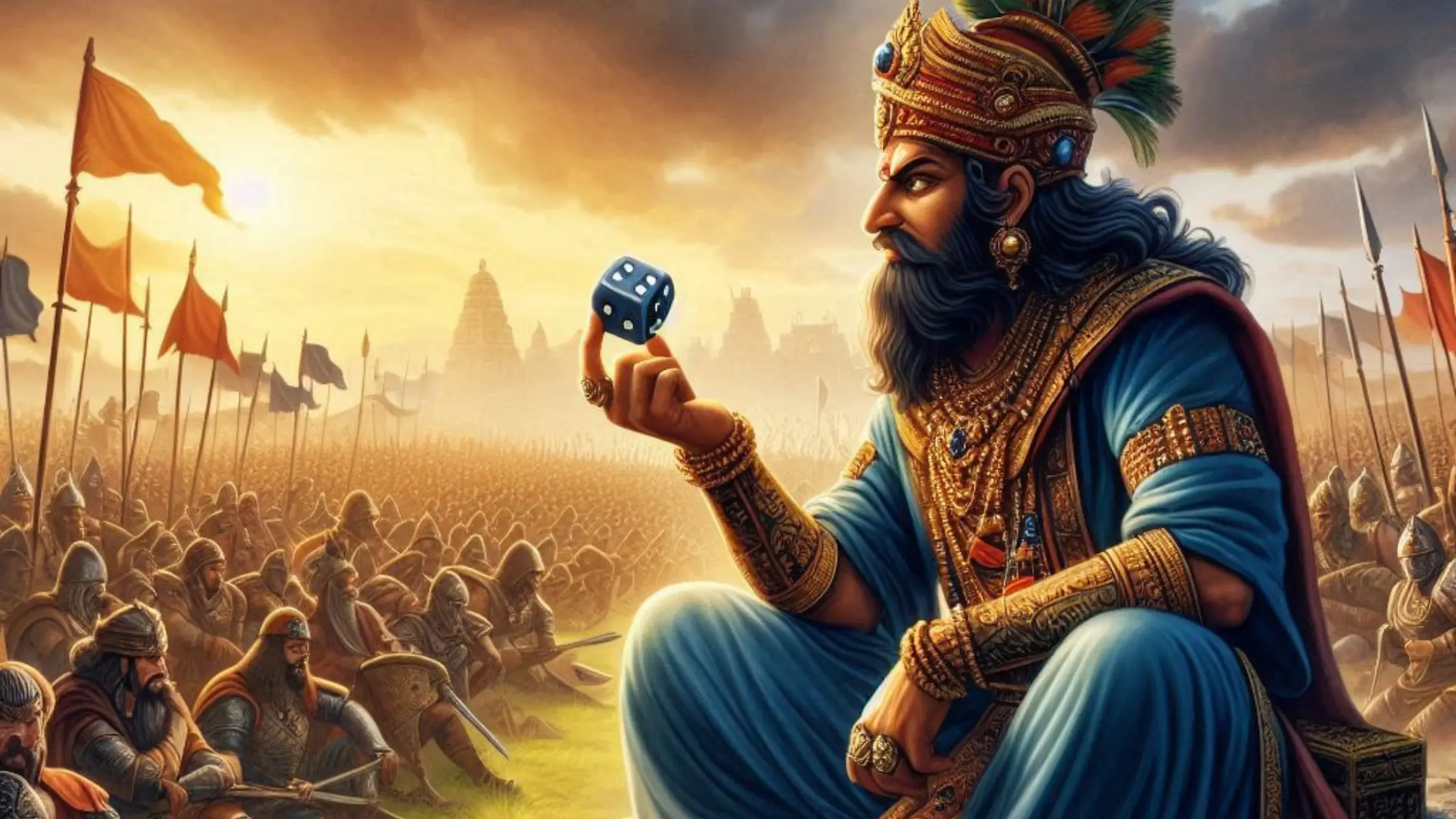Shakuni: Villain or Victim? Untold Mahabharata Story
The epic Mahabharata, one of the greatest stories ever told, is filled with complex characters, intricate plots, and profound lessons. Among the myriad reasons that led to the epic war, the actions of Shakuni, the Prince of Gandhar, stand out as a pivotal catalyst.
His machinations and manipulations were instrumental in fueling the conflict that culminated in the Mahabharata war. But what drove Shakuni to sow discord and destruction? What was his hidden agenda?
Origins of Shakuni’s Hatred
The story begins with Bhishma Pitamah’s quest to find a suitable bride for Dhritarashtra, the blind prince of the Kuru dynasty. Bhishma’s search led him to the kingdom of Gandhar, which many believe corresponds to present-day Kandahar in Afghanistan.
Gandhar’s king, often referred to as Gandharv Naresh, was hesitant to marry his daughter, Gandhari, to a blind man. However, facing pressure and the political might of the Kuru dynasty, he reluctantly agreed.
What Bhishma did not know initially was that Gandhari was a Manglik, an astrological condition considered inauspicious for marriage without specific rituals. To mitigate this, Gandhari had been first married to a goat, which was then sacrificed.
This revelation came to light after the marriage, infuriating Bhishma, who felt deceived.
Gandhari’s Sacrifice and Shakuni’s Resentment
Gandhari, out of loyalty to her husband, chose to blindfold herself for life, vowing to share in his darkness. This act of unparalleled loyalty and sacrifice pained Shakuni deeply. He loved his sister dearly and was devastated by the injustice she had to endure.
This further fueled his animosity towards the Kuru dynasty.
Imprisonment and Starvation of Gandhar’s Royal Family
In a fit of rage, Bhishma invited Gandhar Naresh and his family to Hastinapur, under the pretext of a warm welcome. Upon their arrival, they were confined to a cell and subjected to a cruel starvation tactic, receiving only a handful of rice each day.
This meager ration was insufficient, leading to the slow death of many family members. The survivors, including Gandhar Naresh and his son Shakuni, made a desperate decision to save their legacy.
Shakuni, chosen by his family, consumed the entire handful of rice each day to ensure his survival. He watched helplessly as his loved ones perished, one by one. This harrowing experience sowed the seeds of intense hatred and a burning desire for revenge in Shakuni’s heart.
Legacy of Revenge
Before succumbing to starvation, Gandhar Naresh made a final, crucial move. Using his remaining strength, he broke Shakuni’s knee, ensuring that his son would carry a permanent reminder of their family’s suffering. He also instructed Shakuni to craft dice from his bones, which would always yield the desired numbers.
This magical gift became Shakuni’s primary weapon in his quest for vengeance.
Shakuni’s sister, Gandhari, was married to Dhritarashtra against her will, further fueling Shakuni’s resentment towards the Kuru dynasty. Determined to avenge the wrongs done to his family, Shakuni embarked on a mission to destroy the Kuru clan from within.
He filled Duryodhan’s ears with poisonous advice, stoking his ambitions and hatred towards the Pandavas. His manipulations led to the infamous game of dice, where the Pandavas lost everything, including their wife Draupadi, leading to her humiliation.
Shakuni’s Role in Key Events
Shakuni’s intelligence and strategic mind were evident in several key events that shaped the Mahabharata:
- The Poisoning of Bheem: Shakuni was involved in the plot to poison Bheem, one of the Pandavas, hoping to eliminate a formidable adversary early on.
- The Lakshagraha Conspiracy: Shakuni masterminded the plot to burn the Pandavas alive in the house of lac, a cunning attempt to end their lineage.
- The Game of Dice: Using his magical dice, Shakuni orchestrated the infamous game where Yudhishthira, the eldest Pandava, lost his kingdom, wealth, and Draupadi, leading to her public humiliation.
The Final Confrontation
Shakuni’s cunning strategies orchestrated the events leading to the great war of Mahabharata. He witnessed the fall of stalwarts like Bhishma Pitamah, Guru Dronacharya, and Karna, and the eventual destruction of the Kauravas.
Despite his satisfaction in fulfilling his revenge, Shakuni was not spared in the end.
On the 18th day of the Kurukshetra war, Shakuni faced Sahadev, the wisest of the Pandavas. In a poignant moment, Shakuni confessed his life’s story to Sahadev, revealing his motivations and the weight of his actions.
Knowing his end was near, Shakuni fought valiantly but was ultimately slain by Sahadev, thus fulfilling his father’s mandate for vengeance.
Shakuni’s Legacy
Despite his numerous sins and the chaos he unleashed, Shakuni is believed to have attained heaven after his death. His story, often overshadowed by the larger-than-life heroes of the Mahabharata, is a testament to the depths of human emotion and the lengths one can go for familial loyalty and revenge.
Moral and Philosophical Reflections
Shakuni’s tale underscores the cyclical nature of violence and the destructive power of revenge. His actions, driven by a desire for retribution, led to immense suffering and the eventual downfall of the very people he sought to protect. His story serves as a reminder that the pursuit of vengeance often consumes both the seeker and the target.
The tale of Shakuni serves as a reminder that history is often written by the victors, but the stories of those who play pivotal roles behind the scenes remain equally important.
His life, filled with tragedy and retribution, is an integral part of the Mahabharata’s rich tapestry.
Disclaimer: I wanted to take a moment to clarify that some of the articles we have written are factually correct, supported by verified data and sources. These articles provide accurate information that our audience can rely on.
However, there are also articles that are based on personal opinions. While these pieces offer valuable insights and perspectives, it's important to recognize that they reflect the views of the authors and may not be universally applicable or agreed upon.
